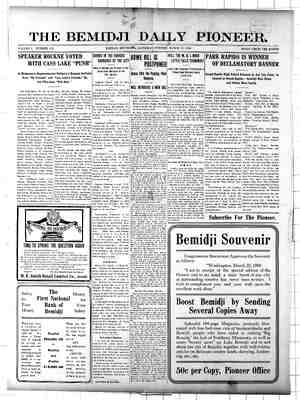Bemidji Daily Pioneer Newspaper, March 27, 1909, Page 27
You have reached the hourly page view limit. Unlock higher limit to our entire archive!
Subscribers enjoy higher page view limit, downloads, and exclusive features.
s § « i { | | .i | BEMIDJI, BELTRAMI COUNTY AND NORTHERN MINNESOTA. THE GREAT RED LAKE COUNTRY. (Scene on the old Leech Lake, Reed Lake and Winnipeg Indian Trail, where trail crosses the river, in the Townsite of Redby. This trail, from the Red Lake Agency to Leech Lake, is still a hard, well-beaten path, and is used by the stage operating between Redby and Red Lake Agency. This point was the camping ground and restin g place of the Indians for many years.) A section of the state which is as yet practically undeveloped, and which has been scarcely touched by the hand of the white man, is the great domain of virgin soil which surrounds Red Lake, in the central portion of Beltrami county, but a few miles north of the city of Bemidji, where the members of the Red Lake band of Chippewa Indians have made their hunting and fishing headquarters for several hundred years past, and where the fertile acres have ever been the pride of the copper-colored denizens of the pines who gloried in the possession of the larg- est body of fresh water wholly within the boundaries of the United States. For many years past much of the land about the upper and lower Red Lakes has been set aside as an official reservation for the Red Lake Indians, and the country thereabouts is still in the wild state created by nature, awaiting the advent of the thrifty tiller of the soil to develop the lands and bring out the great pro- ductiveness of the soil of the Red Lake country. During the past ten years, the white man has been making inroads into the Indian <country around Red Lake, with the result that the Indian reservation has been diminished, the Reds selling a large portion of their original reserve, and mak- ing their homes along the lake shore, where they had hunted and fished for generations. A considerable portion of the lands for- merly included dn the reservation has recently been opened to settlement and cultivation by homeseekers :who desired to locate on the fertile acres, and there is a general demand that other portions of the land be also thrown open, afford- ing homes for farmers. The Upper and Lower Red Lakes and their tributaries afford retreats, on the shores, for the largest bands of caribou still in existence in the United States, and the country is the natural habitat of




